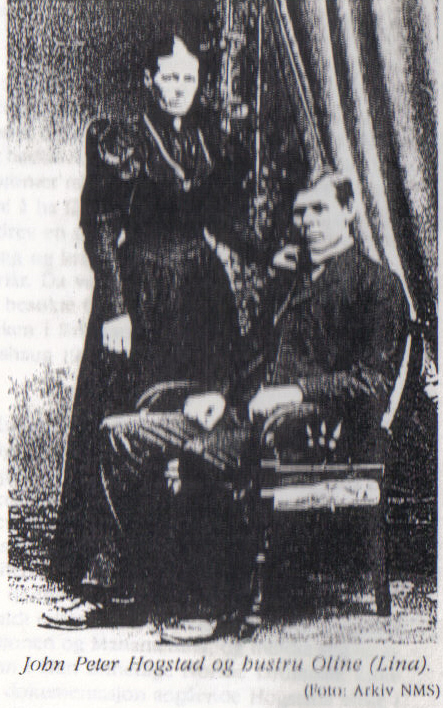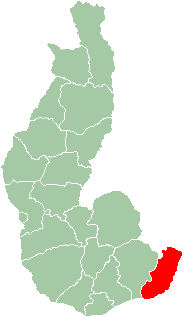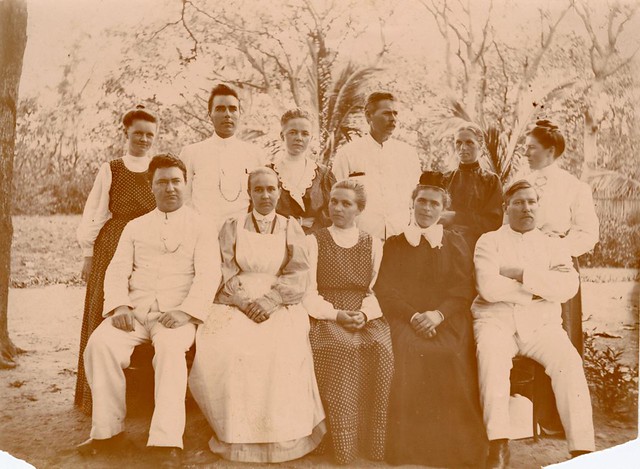When I began my genealogical journey 12 years ago, I never imagined that I’d have any kind of connection to Madagascar, remote as it is. Surprise, surprise!
{Sorry for the poor quality of this picture, but it is a scan of a photocopy that was given to me by a distant cousin.}
 Rev. John Peter Hogstad was my first cousin, three times removed. He was my great-great grandfather’s sister’s son. Even though he is not a direct-line ancestor, he had such an interesting life that I wanted to share a little bit about him here.
Rev. John Peter Hogstad was my first cousin, three times removed. He was my great-great grandfather’s sister’s son. Even though he is not a direct-line ancestor, he had such an interesting life that I wanted to share a little bit about him here.
John Hogstad was born on 2 Dec 1858 in Inderøy, Norway. He was the son of Ole Pedersen Hogstad and Anna Martha Petersdatter Melhus. Anna was a sister to my great-great grandfather, Peter Andrew Melhus.
He immigrated to the United States with his parents in 1866. They settled in Renville county, Minnesota.
{Incidentally, this answered my question as to why my 2nd great-grandfather settled in Renville county in 1888. He already had family there!}
1887 was a very busy year for John.
"Norwegian-American Studies, Volume 34" published by the Norwegian-American Historical Association (NAHA) in 1995. :
Hogstad was ordained during the Conference's annual meeting, held 8-15 June 1887, in Hogstad's home county (whether by chance or design is not known), at Hawk Creek Lutheran Church, near
Sacred Heart, Minnesota. It was decided that because of the historical importance of this first ordination of a foreign missionary from their ranks, Hogstad would be individually ordained at a huge mission festival rather than with his classmates, as would have been normal. The mission festival was held on Sunday, 12 June. Georg Sverdrup preached on a text
from Matthew 12:38-42 (the sign of Jonah). Then the candidate's curriculum vitae was read and a charge was given by the president of the Conference, Gjermund Hoyme, on a text from Isaiah 6:8 ("Whom shall I send? And who shall go for us?"). So it was that John Peter Hogstad and
his wife went from the young immigrant Church in the United States to found another young Church on distant shores. Just before his ordination John had married his sweetheart Oline (Lina) Grodal, who was born in Elverhøi in Sunndal in western Norway on 11 July 1854. An older sister, Gjertrud, had emigrated to the United States and her "America letters" home to Norway eventually influenced Lina to decide to emigrate as well, which she did in 1883. Since Lina's sister resided in Minneapolis, that is naturally where Lina went also. How she and John met is not known, but it is likely that they met at Trinity Church, which was next door to Augsburg and long had close ties to that school. Or it is also possible that they met while Hogstad, as a faithful member of the students' missionary society, was teaching Sunday School at some neighboring church. At any rate, they met, fell in love, and decided together to go into foreign missionary service. The couple were married at John's parents' home in Camp, Minnesota, on 7 May 1887. The newly married missionary couple departed for Madagascar on 18 July 1887. They stopped in Stavanger, Norway, on their way to Madagascar so that the directors of the NMS could meet this first American to serve under their auspices.”"The Hogstads arrived in Madagascar some time in the middle of September, 1887, landing at Toamasina on the east coast. The missionaries did not linger long in Toamasina, then infested with malaria. Instead they set off on the 19th of September for the capital city, Antananarivo.”
“After a period of time in the capital for orientation, the Hogstads were sent to the interior region of Fisakana for language study.While the Hogstads and the other members of the new group of missionaries from the NMS were studying Malagasy the NMS decided on its strategy. Much like the European nations at this period in history, mission societies deemed it important to "plant the flag" and thus claim territory for one's nation or mission. For this reason, this new class of missionaries were not sent to augment staffs at older sites but instead were spread around the island in order to define the field for the NMS and thus to exclude other mission groups. Hogstad deeply resented this policy and complained of it bitterly to Sverdrup in his letters. He particularly resented the fact that not only was he at the most isolated site of all, Fort Dauphin, but that the directors of the NMS did not write to him to encourage him, as he knew they did for the "real" Norwegian missionaries. Hogstad became convinced that the NMS did not really want any more American missionaries but was afraid to say so because they needed the American money. Nevertheless, the Hogstads arrived in Fort Dauphin on 14 September 1888. They were led down to their new field of work by veteran NMS missionary Peder Eilert Nilsen-Lund, sometimes called the "Livingstone of Madagascar" because of his two pioneering exploratory trips through the southern part of Madagascar to find posts for new NMS missionaries. John Hogstad did not begin his work among a people totally unfamiliar with the Christian faith, though some of their earliest experiences of
Christians had not left favorable impressions.”“…the region that the Hogstads came to evangelize was in a state of turmoil.”
“With more work than he could do alone, Hogstad soon acquired the services of a Malagasy assistant, a man whom Hogstad redeemed from slavery from one of the Merina officers and to whom he gave the name Rabenjamina. The price of the man's freedom was $70.”
“Besides a simple elementary school, Hogstad also opened a special school for the training of evangelists within two months after his arrival in Fort Dauphin."
Can you even imagine?? I sure can’t!!
The settled in Fort Dauphin {present day Tolanaro} in the southern part of the country.
 According to Wikipedia, “Fort Dauphin was the headquarters of American Lutheran missionaries who worked in southern Madagascar starting in 1888 for almost 100 years. They were engaged in community development, education, evangelism and medical work and also operated what was known as the “American School” and the “Missionary Children’s Home”.”
According to Wikipedia, “Fort Dauphin was the headquarters of American Lutheran missionaries who worked in southern Madagascar starting in 1888 for almost 100 years. They were engaged in community development, education, evangelism and medical work and also operated what was known as the “American School” and the “Missionary Children’s Home”.”
From Norwegian-American Studies, Volume 34" published by the Norwegian-American Historical Association (NAHA) in 1995:
"While John Hogstad taught the boys in his school and the young men in the "Efa-polo lahy" school, Lina Hogstad began to gather a class of girls to whom she taught handwork, reading and writing, and the rudiments of the Christian faith. This work eventually evolved into a full-fledged women's school..."
"In 1893 the Hogstads and the young American Lutheran Mission were augmented by yet another new couple: Reverend Gabriel Isolany, who was born in Madagascar of Norwegian missionary parents and graduated from
Augsburg Seminary, and his wife Inga. With the coming of these reinforcements the Hogstads were able to return to the United States, after a sojourn in Norway, for a furlough for all of 1894 and most of 1895."
I am not sure on the dates, but I believe that it was during this above-metioned furlough that Rev. Hogstad preached on Epiphany Sunday at the Sakshaug Church, where so many of my ancestors attended.
I’m not going to get into all of the things I read about the changes within the Lutheran Church at this time period. It’s confusing. Suffice it to say that it influenced the Hogstad’s missionary work and they ended up being forced to start their work over in a completely different area – Manantenina. It caused him to be isolated from most of his other colleagues. Another blow to his work was the fact that Madagascar became a French colony.
They took another furlough in 1903 – and stopped off in Norway again, but apparently this time they stayed so long in Norway that the Board of Directors of the Mission practically had to order them back to the United States to report on their work. I can only imagine that they were enjoying themselves – being around family and cooler weather. 🙂
I love Google. I was able to find this beautiful picture of a group of Madagascar missionaries from 1907. Peter and Oline Hogstad are the 4th and 5th from the left in the back. This picture is from the Evangelical Luthern Church of America archives. What a find!
Unfortunately, Rev. Hogstad’s missionary work was cut short by his death in 1911.
From Norwegian-American Studies, Volume 34" published by the Norwegian-American Historical Association (NAHA) in 1995:
"The archives in Madagascar are mostly lost, and very little record remains of Hogstad's last years in Madagascar.Sometime in mid-October, 1911, Hogstad became violently ill with blackwater fever, a complication of malaria which killed many missionaries and colonialists during this period. He had suffered this usually fatal disease on at least two previous occasions, but survived. Lina Hogstad arranged for some Malagasy porters to carry Hogstad the 110 kilometers down the coast to Fort Dauphin where there were French doctors and fellow missionaries to help nurse the sick missionary back to health. Hogstad lost consciousness on the trip but made it to Fort Dauphin alive. He lingered there in a coma for several days before he died on 24 October 1911.
John Peter Hogstad was buried in the missionary plot in the city graveyard in Fort Dauphin, the town where he began his missionary career. Perhaps also feeling betrayed, Oline Hogstad did not return to the United States to live. She settled in Norway, the land of her birth, and died there on 19 June 1943.“
A Google search produce a lovely picture of his gravestone in Madagascar on the website www.mhs.no, a School of Mission and Theology in Norway.

This makes me want to add Madagascar to the list of places I want to visit someday!! 🙂
Do you have any missionaries in your family tree? If so, where did they do their work?







